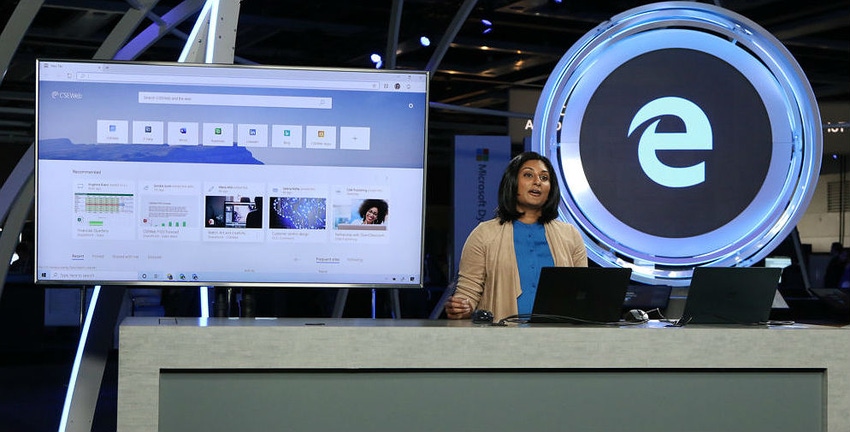Microsoft's updated Edge browser focuses on user productivity and privacy controls.
May 17, 2019

(Pictured above: Microsoft’s Divya Kumar at Build 2019 in Seattle.)
It may be an uphill battle, but Microsoft is gunning to become relevant in the browser wars again, one of many areas it was once dominant. While use of Edge, the browser that replaced Internet Explorer, is marginal, Microsoft has developed a revamped version that addresses compatibility concerns and is packed with an extensive set of new privacy controls and productivity features.
Microsoft demonstrated its overhauled Edge browser for the first time during last week’s Build conference in Seattle, where the company released the first private preview to developers. A public preview will follow in the coming months, Microsoft said. The new browser will give partners an alternative web interface to build their solutions around, while enabling users to comfortably embrace multibrowser usage models.
However, getting partners, ranging from commercial ISVs, SaaS providers and custom software integrators, interested in bringing Edge into the fold might not be easy, given its current lack of adoption. Microsoft’s IE was the dominant web browser for most of the first two decades of the web era. IE usage began to dwindle about a decade ago following the release of Google’s Chrome browser, which enabled more modern web experiences.
Given the code base in IE, Microsoft decided to start from scratch, bringing Edge to Windows 10 when it arrived in 2015. Now used for legacy applications, as of April, IE is used by less than 2.6% of all sessions worldwide. Minute as that is, even fewer use Microsoft Edge, less than 2.2%, according to StatCounter. Google Chrome is now the most widely used browser, accounting for more than 63% of sessions, with Apple’s Safari coming in at a distant No. 2, at just over 15 percent.
With nowhere to go but up, in December, Microsoft pivoted its strategy with Edge by announcing plans to replace the core EdgeHTML engine with Chromium, the same engine that’s in Google’s Chrome browser. Chromium, maintained by Google, is available under the BSD open-source license. The move also meant the end of the road for Edge UWP, the Universal Windows Platform app version of the browser.
By replacing EdgeHTML with Chromium, Microsoft signaled it would embrace an open-source approach to rendering web content, while allowing the company to position its browser as a viable alternative or companion user experience. Microsoft also is making Edge available on MacOS, in addition to support for Windows 7, iOS and Android.
The company also has become a contributor to the open-source Chromium Project, where it already has contributed ARM64 support and accessibility IP. Putting Chromium in Edge will address core browsing compatibility issues, Microsoft is reasoning, while letting it address other areas of the browser.
“I think the world is ready for another choice when it comes to web and innovation,” said Microsoft CEO Satya Nadella, speaking during the opening keynote session at Build.
“Migrating to Chromium will make Edge …
… much easier for third parties to develop,” said Dharav Jhaveri, director of operations at Microsoft gold partner SoHo Dragon, in an interview.
3 New Features Coming to Edge
Microsoft underscored the three core new areas where it says Edge will stand out: the new privacy controls; the Collections feature that lets users gather content from various sites and consolidate it onto a common canvas; and a new IE mode that renders the legacy browser as a tab in Edge.
While Edge has come with an IE mode in the past, a necessity to address existing applications and sites that require IE in order to work, the implementation in Edge effectively launched a virtual IE interface in a separate environment — a less-than-ideal experience. The new Edge will run an IE component natively as just another browser tab.
“No more jarring experiences when you hit an internal site that needs Internet Explorer,” said Divya Kumar, a group product marketing manager on Microsoft’s Edge development team, during a demo of the new browser.
That will be a welcome feature to users and web developers alike, said James Governor, founder and analyst at RedMonk.
“They should have done that in the first place,” said Governor, who was even more intrigued with the Collections feature, which will allow users to gather snippets of content from different sites and bring them together in an organized and clean presentation.
Kumar demonstrated the Collections feature, by a scenario of shopping for cameras. Collections let her gather information from various sites and bring them together into Office files such as Word, Excel or PowerPoint by clicking on a new “Collections” tab.
“Edge creates a clean document, even automatically includes citations; how cool is that?” she said.
SoHo Dragon’s Jhaveri said that could become a welcome new capability.
“This will make things much easier for end users,” Jhaveri said. RedMonk’s Governor agreed. Moreover, by standardizing on the core browsing experience, he said perhaps more innovation such as Collections will appear on Edge and other web browsers.
“I think all of the browser manufacturers should be finding interesting things to do with the technology,” he said.
The new privacy features center around giving users more control over how they are tracked. The feature under development showcased by Microsoft will allow users to select among three options for how they’re tracked. Users who are already comfortable with receiving targeted ads will be able to leave the browser in unrestricted mode. Those who don’t want to be tracked can cut off that capability with the Strick option and users who only want to be tracked on sites they have already visited can choose the Balanced mode.
Read more about:
VARs/SIsAbout the Author(s)
You May Also Like


